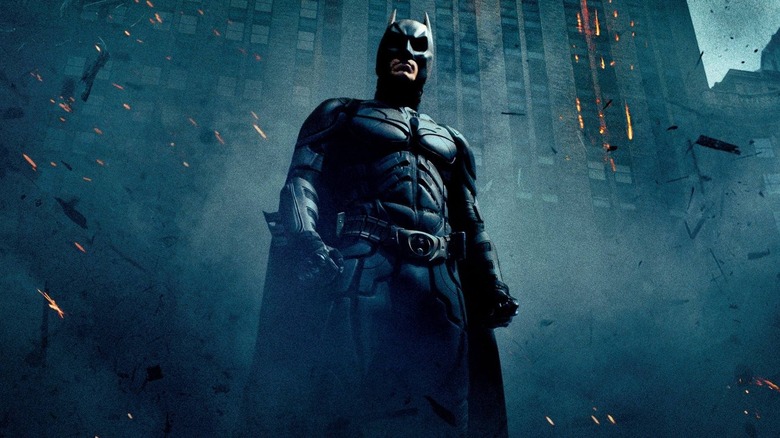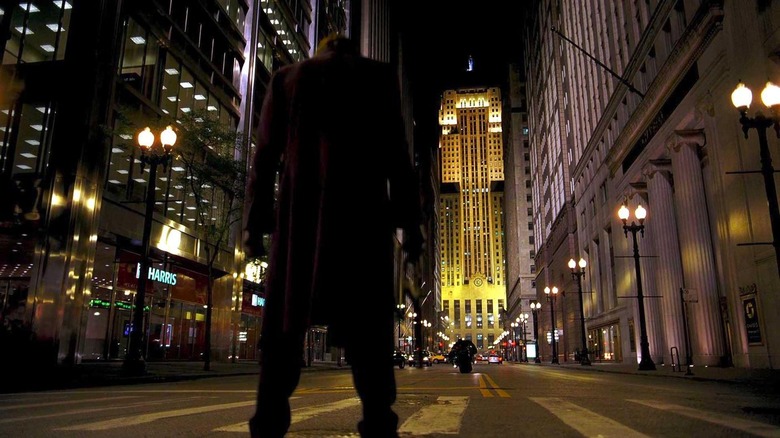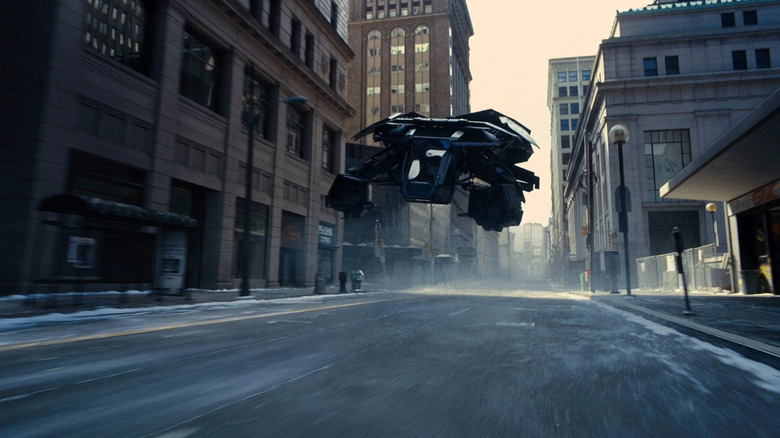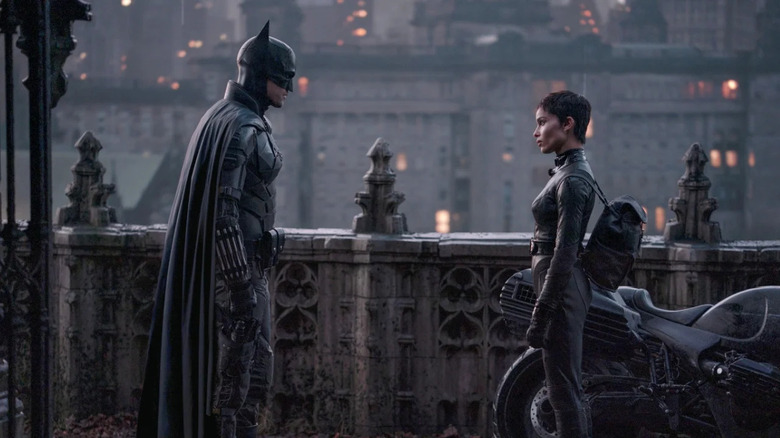Why The Dark Knight Redesigned Gotham From The Ground Up
In Matt Reeves' current take on Batman, the city of Gotham is dark, grimy, and scary as hell. It's a city where it always seems to be raining, and it's normal for gangs of criminals wearing face paint to follow you home on the subway. It's a perfect fit for the noir detective story the movie's telling, and has a whole different feel from the last time Gotham was portrayed in a proper Batman movie.
Christopher Nolan's "Dark Knight" trilogy, meanwhile, took place in a version of Gotham that generally felt like a real major city. Although the Gotham in "Batman Begins" had the gothic, often fantastical vibes that fans of the comics are familiar with, "The Dark Knight" changed things up, and the city felt more like a stand-in for Chicago. Regarding the difference between the first two films, director of photography Wally Pfister explained:
"We were aiming for that grittier style, but I still felt an obligation to the studio to put a sort of polished, big-budget look on it. By the time we did 'The Dark Knight,' though, we could do whatever we wanted to!"
And that's exactly what they did. "The Dark Knight" featured a modern, realistic city that better represented the tone Nolan was going for. Heavily based on Chicago, this version of Gotham feels like any city in modern day America, which allows the Joker's subsequent reign of terror to hit harder.
A modern Gotham
Because a large portion of Gotham was destroyed at the end of "Batman Begins" (including Wayne Manor and the monorail train), this offers a plausible explanation for why the city looks so different in "The Dark Knight." It also helped on a thematic level; since "The Dark Knight" initially argues that Batman's attempts to clean up Gotham in the time between movies has been successful, it makes sense that this new Gotham would look cleaner, more polished. The new veneer of respectability is part of what the Joker is trying to dismantle. As Pfister put it, "I don't think you'll find a single circle in 'The Dark Knight.' It's all squares and straight lines. That's the structure that the Joker is fighting."
By "The Dark Knight Rises," Gotham has a New York City skyline mixed and streets that look like Pittsburgh (where it was filmed). It continues the trajectory of making Gotham look nicer with each movie (at least, the beginning of each movie, before the villain ruins everything), a visual representation that Bruce Wayne's decisions have, in fact, been making a positive impact.
The sheer extent to which Gotham changes from "Batman Begins" to the rest of the trilogy is still jarring, though. Despite the thematic and in-universe explanations for this change, the fact that the city's been redesigned to the point where it's almost unrecognizable from the first movie makes the trilogy feel a little disjointed. It almost feels like "Begins" is part of a different franchise than the other two movies. While "Batman Begins" still seems like it's trying to maintain a comic book feel, the setting of "The Dark Knight" indicates a clear desire on Nolan's part to ground the story as much as possible.
The downsides of realism
Although the real-world design of Gotham in the latter two movies in the trilogy sets up an expectation of realism, some of the negative reception to these movies indicated that this was a double-edged sword. While definitely well-received, "The Dark Knight" was hit with a legendary number of nitpicky reactions from fans and critics. People were quick to point out that Harvey Dent wouldn't actually be able to talk that well with half his face burnt off, or complain that the Joker's plans relied on a lot of variables he couldn't possibly have known about. If the movie wasn't so hellbent on "realism," would people have picked these nits?
"The Dark Knight Rises" was especially picked apart for its plot holes in a way that often overshadowed any kind of deeper examination of the movie's themes or character arcs. It didn't help that the movie came out in 2012, around the beginning of the rise of lazy, nitpick-focused film criticism that led to YouTube channels like Cinema Sins. When Batman set up a flaming bat symbol on one of Gotham's bridges to send a message of hope to the city's citizens, people went straight to asking, when did he have time to do all that?
As much as it'd be nice to blame all this on internet people being internet people, this problem does seem to be a bit of a self-inflicted wound. The discourse around Marvel's movies at the time, which were way more willing to embrace the supernatural elements of their source material, was nowhere near as bogged down in questions about the specifics of the bad guys' plans. That's because, unlike the "Dark Knight" trilogy, these movies made no declarations of being grounded and realistic, so it was held to a different standard. By setting its latter two movies within what amounts to the "real world," people started looking at Nolan's plots strictly from a perspective of real-world plausibility.
Where Gotham goes from here
This is why it may be for the best that "The Batman" eschews realism in exchange for a more blatantly gothic, almost mystical version of Gotham. As much as Matt Reeves' new Batman movie has a reputation for being dark and gritty like the Nolan films, it goes about it in a way that feels like much more of an embrace of a lot of the Batman comics. It does this by making Gotham feel distinct and otherworldly. It's not a place we can visit in reality.
Matt Reeves' film understands that darkness and realism aren't inherently the same thing, which allows the movie to keep its gloomy tone while also having more freedom with its creative choices. Characters like Poison Ivy couldn't have existed in Nolan's films, but it's not hard to imagine them existing in the Battinson universe. "The Batman" walks this tightrope main through its depiction of Gotham, a city so absurdly gothic and moody that no one would ever look at it as just a stand-in for Chicago.



